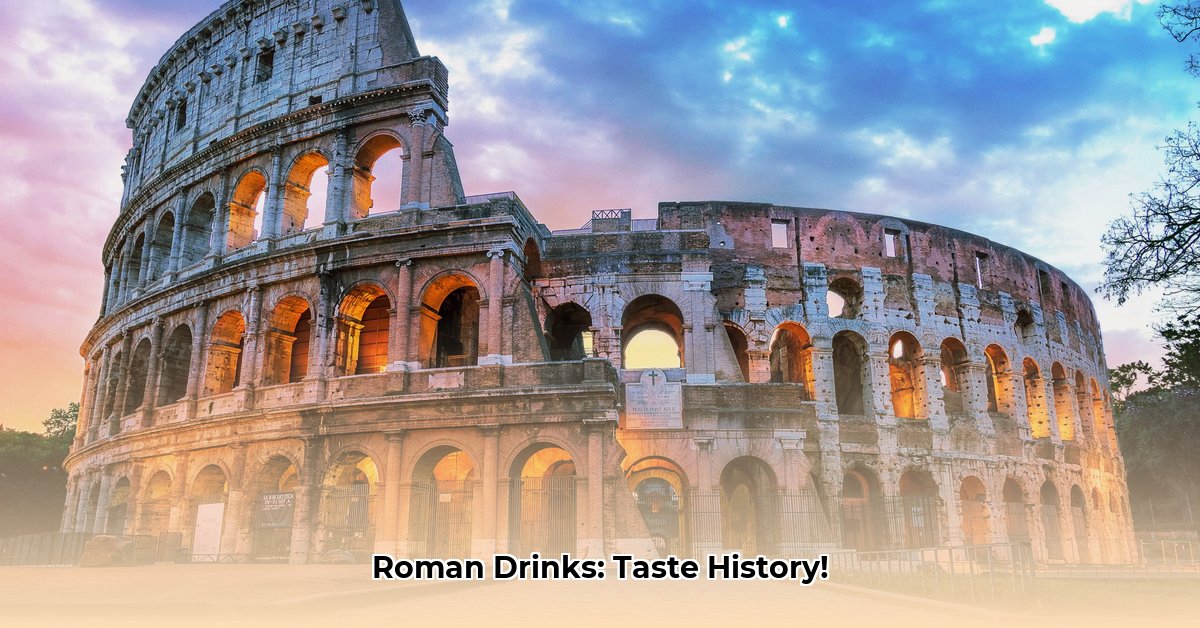Imagine hydrating in ancient Rome. What would you be sipping? Forget modern sodas or even the crisp wines we know today. In the vast Roman Empire, your daily drink was far more than just a thirst quencher; it was a potent symbol of social status, a testament to practical resourcefulness, and a critical component of military might. Looking for more food inspiration? Check out these Roman recipes.
From the lavish feasts of the patricians to the arduous marches of the legions, Roman beverages tell a compelling story of ingenuity, survival, and societal stratification. We’re about to uncork the rich history of ancient Roman drinks, exploring the prized elixirs of the elite, the robust sustenance that fueled the army, and the basic concoctions that kept the common citizen and enslaved population alive. Get ready to explore a liquid landscape where every sip offers a glimpse into the heart of Roman society.
Water: The Challenging Foundation
Before delving into fermented delights, it’s crucial to understand the fundamental challenge for every Roman: potable water. While the famed Roman aqueducts brought vast quantities of water into cities, ensuring its purity at the point of consumption was a constant struggle. Contamination was a significant concern, especially for those outside the affluent households with private lead pipes. This ubiquitous issue meant that plain water was often viewed with suspicion, making other beverages not just enjoyable, but often a safer necessity for ancient Roman hydration.
Wine: The Ubiquitous Elixir of Empire
Wine, known in Latin as vinum, was unequivocally the most prominent beverage across all strata of Roman society. However, its consumption and quality varied immensely, reflecting the profound social divides of the era.
- Dilution as a Cultural Standard: Unlike modern practices, Romans almost universally diluted their wine with water. Drinking wine neat was considered uncivilized, a barbarian habit associated with drunkenness and lack of self-control. Ratios typically ranged from three parts water to one part wine, to even more diluted mixtures. This practice was not merely for sobriety; it also extended the beverage and made it more palatable, especially for lower-quality wines.
- Flavored Concoctions: To enhance or alter the flavor profile of their wines, Romans frequently infused them with a diverse array of additives. Honey was a common sweetener, leading to drinks like mulsum. Other popular additions included herbs like thyme, rosemary, and mint, along with spices such as saffron and myrrh, to create complex and aromatic beverages. Resin was often added as a preservative, imbuing the wine with a distinctive, somewhat bitter taste.
- A Spectrum of Quality: While wine was accessible to all, the quality was a stark indicator of wealth. The elite indulged in prestigious vintages from renowned regions such as Falernian, Caecuban, Setian, and Massic, often aged for years in large earthenware amphorae (dolia). These esteemed wines were primarily cultivated in Latium and Campania, regions known for their fertile volcanic soil. For the vast majority, particularly the lower classes and soldiers, wine was a far cruder affair, often thin, sour, or even watered down before purchase to maximize profits.
- Cultivation and Production: The Romans inherited winemaking techniques from the Greeks and Etruscans but perfected them on an industrial scale. Vineyards spread across the empire, forming a crucial agricultural industry. The process involved pressing grapes in large vats, allowing the juice to ferment, and then storing the wine in amphorae sealed with resin for preservation.
Posca: The Soldier’s and Laborer’s Sustainer
Posca, a humble yet vital drink, was the backbone of Roman hydration for soldiers, laborers, and the lower classes. Its widespread use highlights Roman practicality and ingenuity in maintaining health and morale across the empire.
- The Power of Vinegar: At its core, posca was a simple mixture of sour wine vinegar (acetum) and water. This seemingly basic concoction was a marvel of ancient chemistry. The acidity of the vinegar acted as a mild antiseptic, effectively killing many of the harmful bacteria found in untreated water sources, thus significantly reducing the risk of waterborne illnesses during long campaigns or in crowded urban environments.
- Affordability and Accessibility: Made from readily available and inexpensive ingredients – often low-quality, soured wine, which was essentially spoiled wine turned into vinegar – posca was economically viable for widespread distribution. Roman legions received vinegar as part of their standard rations, ensuring consistent access to this life-saving beverage.
- Military Cornerstone: Posca was not merely a drink; it was a strategic asset for the Roman army. It prevented dehydration and disease among legions traversing vast territories and engaging in strenuous activities. Famous figures like Cato the Elder and Emperor Hadrian deliberately drank posca alongside their troops to demonstrate solidarity and resilience, reinforcing its reputation as the quintessential cibus castrensis (camp-fare). Historical texts, including Plutarch’s account of Cato and the Historia Augusta referencing Hadrian, attest to its significance. The Gospels also mention oxos (Greek for vinegar) being offered to Jesus during his crucifixion, underscoring its commonality.
- Flavor Enhancements: While functional, posca could be made more palatable with additions. Recipes, such as those mentioned by Aetius and Paul of Aegina, included herbs and spices like cumin, fennel, pennyroyal, anise, and celery seed, transforming it from a simple liquid into a more flavorful and potentially medicinal tonic.
Crafting Your Own Posca: A Taste of Ancient Rome
For those curious to experience a practical piece of ancient Roman history, posca is surprisingly easy to recreate.
1. Ingredients: 4 cups water, 1 cup red wine vinegar (unpasteurized for authenticity), 1-2 tablespoons honey (optional, to taste), a few sprigs of fresh mint or rosemary (optional, for infusion).
2. Preparation: Combine the water and vinegar. If using honey, dissolve it in a small amount of warm water first, then add to the mixture. Stir well. Add mint or rosemary sprigs and let the mixture sit for a few hours in the refrigerator to infuse the flavors.
3. Serve Chilled: Enjoy this bracing and historically significant drink!
Lora: The Beverage of Necessity
At the absolute bottom of the Roman beverage hierarchy lay lora, a drink born purely out of necessity and extreme resourcefulness. This was the ultimate “waste-not, want-not” concoction.
- Second Pressing, Lowest Class: Lora was produced by taking the leftover grape pomace (skins, seeds, and stems) after the initial pressing for wine. This discarded material was then soaked in water, often for an extended period, and pressed again, yielding a very weak, thin, and highly acidic liquid. This process, akin to modern “piquette,” extracted any remaining sugars and flavors.
- The Drink of the Downtrodden: Primarily consumed by enslaved individuals and the very poorest segments of society, lora served as a basic form of hydration. Its taste was likely tart, watery, and far from pleasant, lacking the fermentation depth of even the cheapest wines.
- A Symbol of Disparity: Lora starkly underscores the profound socioeconomic disparities in ancient Rome. While the elite reveled in fine wines and mulsum, the enslaved were relegated to a beverage that was essentially the by-product of their masters’ luxury, highlighting a daily reality of meager subsistence.
Sweet Indulgences and Culinary Essentials
Beyond basic hydration, Romans developed a sophisticated palate for sweetened and spiced beverages, often reflective of higher social status and culinary innovation.
Mulsum: Honeyed Indulgence
Mulsum was a popular honeyed wine, primarily enjoyed by the wealthier classes as an apéritif to stimulate the appetite before a grand cena (dinner).
- A Pre-Dinner Ritual: This drink was typically a blend of quality wine – often heated – infused generously with honey, and occasionally enhanced with exotic spices. It was a customary first course (gustatio) at dinner parties, signaling the beginning of a lavish meal.
- Symbol of Celebration: Mulsum held ceremonial significance as well. It was frequently served at weddings and other festive occasions, symbolizing marital happiness and prosperity, a tradition that echoes in modern mulled wines.
Defrutum: The Versatile Grape Syrup
Defrutum was not a drink in itself, but a crucial culinary ingredient and sweetener derived from grape must (freshly pressed grape juice).
- Concentrated Goodness: To create defrutum, grape must was slowly boiled down over a long period, typically until its volume was reduced by a third. This arduous process concentrated the natural sugars and flavors, resulting in a thick, sweet, and intensely flavored syrup. Variations included sapa (boiled to half its volume) and caroenum (boiled to two-thirds).
- Multipurpose Utility: Defrutum was incredibly versatile. It served as a primary sweetener in both cooking and winemaking, adding richness to dishes and enhancing the sweetness of wines. It was also valued for its preservative qualities, particularly for fruits, and was even used as a coloring agent for dishes and wines. Its long preparation time and extensive use of firewood made it a valuable commodity.
Conditum Paradoxum: The Paradoxical Spiced Wine
Conditum Paradoxum (“paradoxical spiced wine”) exemplifies the Roman elite’s appreciation for complex and exotic flavor combinations. This sophisticated beverage was a precursor to modern mulled wines and liqueurs.
- A Symphony of Flavors: This elaborate spiced wine was created by heating wine and combining it with generous amounts of honey, black pepper, mastic, bay leaves, saffron, dates, and roasted date stones. The mixture was then strained and allowed to cool, resulting in a richly aromatic and sweet-spicy drink.
- Culinary Masterpiece: Recipes for Conditum Paradoxum are famously found in Apicius, the ancient Roman cookbook, highlighting its status as an elite culinary creation and a testament to the Romans’ adventurous approach to flavor.
Beyond the Grape: The “Barbarian” Brew
While wine reigned supreme in much of the Roman Empire, other beverages, particularly beer, held a strong presence in the provinces.
- Cerevisia: The Provincial Favorite: Beer, or cerevisia as the Romans called it, was generally looked down upon by the Roman elite as an unsophisticated, “barbarian” drink. It was associated with the Germanic tribes, Gauls, and Britons.
- Regional Dominance: Despite Roman disdain, beer was a staple in the northern and western provinces, where grapes were harder to cultivate and barley, the primary ingredient for beer, flourished. Local populations had been brewing beer long before Roman conquest, and it remained their preferred daily beverage.
- A Matter of Climate and Taste: The prevalence of beer in these regions was largely a matter of agricultural practicality. Furthermore, the robust, malty character of beer offered a distinct contrast to the more acidic or flavored wines, catering to different regional tastes and climates.
The Drink of a Soldier: Fueling Roman Might
The Roman soldier’s diet, including their beverages, was meticulously planned to ensure maximum endurance and effectiveness during campaigns. Hydration and sustenance were critical for a fighting force that could march for long distances across varied terrains.
- Water Sourcing: While posca provided a safer alternative, soldiers still needed to find and transport water. Roman military engineers were adept at identifying water sources and constructing temporary aqueducts or wells to ensure supply.
- Rationing and Logistics: The Roman army’s ability to provision its legions was a marvel of ancient logistics. Soldiers typically carried their own rations, which included dried grains (primarily wheat, sometimes barley), salted meat (often bacon), cheese, and a supply of vinegar for posca. These rations provided the high caloric intake needed for their physically demanding lives.
- Barley as Punishment: Interestingly, barley sometimes served a dual purpose beyond basic sustenance. For minor military offenses, soldiers might be punished by being forced to consume barley rations instead of the usual wheat, highlighting the grain’s lower status and the use of dietary inconvenience as a disciplinary tool.
- Wine for Morale and Medical Purposes: While posca was the practical daily drink, wine also played a role in military life. Lower-quality wines were consumed for morale, especially during periods of rest, and were sometimes used for their antiseptic properties in treating wounds or purifying water when vinegar was scarce. High-ranking generals, as exemplified by Hadrian, would occasionally share posca with their troops to foster camaraderie, yet they also had access to better quality wines privately.
A Taste of Roman Society
The array of ancient Roman drinks offers a profound lens into the daily realities and complex social tapestry of one of history’s most powerful empires. From the vital, utilitarian posca that fueled legions and sustained the poor, to the highly refined and symbolic mulsum enjoyed by the elite, each beverage tells a story. They underscore the Romans’ remarkable practicality, their hierarchical societal structure, and their surprising culinary innovations. Understanding what they drank is to truly understand the very essence of ancient Roman life.
| Drink | Primary Ingredients | Predominant Consumers | Key Characteristics & Cultural Significance |
|---|---|---|---|
| Wine (Vinum) | Grapes, water (often diluted), sometimes herbs/spices | All classes | Ubiquitous; quality varied by wealth; almost always diluted; infused with honey/spices; central to social gatherings and religious rites. |
| Posca | Sour wine vinegar, water, (optional) herbs/spices | Soldiers, laborers, poor | Cheap, antiseptic (purified water), refreshing, crucial for military endurance and civilian survival in unsanitary conditions. |
| Lora | Grape pomace, water (second pressing) | Slaves, the extremely poor | Weak, thin, acidic; lowest-tier beverage, highlighting extreme resourcefulness and societal inequality. |
| Mulsum | Wine, honey, (optional) spices | Wealthy | Sweet, aromatic apéritif; served before meals to stimulate appetite; symbol of luxury and often used in celebratory rituals like weddings. |
| Defrutum | Boiled-down grape must | All classes (as an additive) | Thick, sweet syrup; used as a sweetener, preservative, and coloring agent in various dishes and wines; valuable due to labor-intensive production. |
| Conditum Paradoxum | Wine, honey, black pepper, saffron, dates, spices | Wealthy | Complex, aromatic spiced wine; a sophisticated beverage for the elite, showcasing advanced Roman culinary experimentation. |
| Beer (Cerevisia) | Barley, water, (optional) herbs | Provincial populations (Gaul, Britannia) | Viewed as a “barbarian” drink by Romans, but a staple in northern provinces where grapes were less common; suited to local climates and tastes. |
Valete – farewell – and may your next drink be as historically rich as these!










